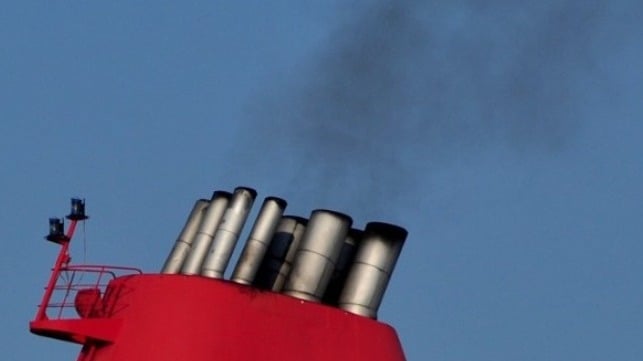An IMO Commitment to Polar Fuels Could Cut Black Carbon Emissions

The International Maritime Organization’s (IMO) Pollution Prevention and Response (PPR) subcommittee meets in London from January 27th to 31st to consider important unfinished business related to the environmental and climate impacts of international shipping’s growing presence in the Arctic. With this sensitive region being the canary in the mine for global climate breakdown, and with 2024 marked as the first year the Earth surpassed 1.5 degrees Celsius of warming, it is crucial to pay close attention to what happens - or does not happen - during this meeting.
The question, unresolved since 2011, is whether the IMO should take mandatory action and impose requirements on the shipping industry to cut black carbon emissions in and near the Arctic. The Arctic is already at 2.5oC heating, with international shipping among the sectors contributing to this warming With the Arctic warming now four times faster than the rest of the planet and the short-lived climate forcer black carbon emitted in or near the Arctic being five times more potent a climate pollutant than when emitted outside the Arctic, it’s clear that the shipping sector must act.
Black carbon emissions from the shipping sector’s burning of residual fuels, such as heavy fuel oil (HFO), are a several thousand times more potent climate forcer than CO2 in the short term, and threaten the snow and ice-covered regions of the Arctic, primarily due to loss of albedo when it deposits on reflective surfaces.
Fortunately, fuels like HFO can be replaced with distillates or other cleaner fuels which can cut black carbon emissions by over 50%, and reduces their climate warming impacts drastically - effectively overnight. Thousands of ships already switch between residual fuels and distillates on a regular basis when entering IMO designated emission control areas (ECAs), with any additional fuel cost fully built in and accepted by the shipping industry. In the Arctic, distillate fuel is readily available and in widespread use, mainly by smaller vessels. However, larger ships, oil and chemical tankers, bulk carriers and general cargo vessels can and must implement a fuel switch.
Following IMO discussions in 2024 regarding the concept of ‘polar fuels’ - fuels acceptable for use in polar waters due to the lower emissions of black carbon - the International Organization for Standardization (ISO) proposed to define the characteristics of such polar fuels using four fuel quality criteria, the same that are used to characterize DMA distillates in the 2024 ISO standard. Since DMA dominates the global marine distillate market, these lower black carbon-producing DMA distillates – i.e. ’polar fuels’ - can be supplied to ships and bunkerers anywhere required for Arctic operations. The challenge for PPR12 will be to agree on the fuel quality criteria that would define ‘polar fuels,’ opening the way for a mandatory approach to the use of these fuels and other new and existing non-residual fuels with similarly low black carbon emissions in the Arctic under MARPOL Annex VI.
A second Arctic-specific issue under consideration at PPR12 concerns oil spills. Norway has proposed a possible definition of polar oil fuels which would be acceptable for use and carriage for use as fuel in Arctic waters under MARPOL Annex I. Norway first proposed to expand the output on reducing the risks of use and carriage of heavy fuel oil to include an upper pour point limit (the lowest temperature at which a fuel or lubricant will flow under specific conditions) in the definition of HFO in 2022. New fuel blends created to meet the requirements of the 2020 global 0.5% sulphur fuel cap have pour points above 0oC. Virtually all distillates including the proposed DMA ‘polar fuels’ have pour points of 0oC or less. Norway proposes a slightly different definition for ‘pour point polar fuel distillates’ than the ISO proposal for ‘distillate polar fuels’ which reduce black carbon.
Norway’s proposed MARPOL Annex I amendment encompasses the Polar Code’s Arctic Waters. This area however excludes a large part of the Arctic around Iceland and off the Norwegian coast, where ship activity and black carbon emissions are very high. To be effective at reducing black carbon emissions, a polar fuels regulation would need to cover the whole Arctic and not just the waters where ice cover or loose ice is likely to be present.
The IMO has committed to take global regulatory action to cut ship CO2 and greenhouse gas emissions at a meeting of its Marine Environment Protection Committee (MEPC 83) in April. The fact that black carbon isn’t a greenhouse gas but a form of particulate matter - soot - should not be an obstacle to similar regulatory action to reduce Arctic black carbon ship emissions and the impact on the Arctic.
In fact, in light of the strength of black carbon’s radiative forcing effect and given that the Arctic is facing the likelihood of exceeding multiple climate thresholds or ‘tipping points’ - the loss of summer sea ice, melting of the Greenland ice sheet, slowing of the Atlantic Meridional Oceanic Circulation (AMOC) - the IMO should not hesitate to act now to reduce black carbon emissions.
It is imperative that during PPR 12, member states endorse the concept of polar fuels - including distillate-grade marine fuels such as DMA or new fuels resulting in comparable or lower black carbon emissions - and agree as a matter of urgency to regulate emissions of black carbon from Arctic shipping.
Bill Hemmings is Black Carbon Advisor to the Clean Arctic Alliance.
The opinions expressed herein are the author's and not necessarily those of The Maritime Executive.
